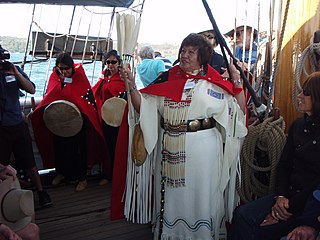Related Research Articles

The Arapaho are a Native American people historically living on the plains of Colorado and Wyoming. They were close allies of the Cheyenne tribe and loosely aligned with the Lakota and Dakota.

The Cheyenne are an Indigenous people of the Great Plains. Their Cheyenne language belongs to the Algonquian language family. Today, the Cheyenne people are split into two federally recognized nations: the Southern Cheyenne, who are enrolled in the Cheyenne and Arapaho Tribes in Oklahoma, and the Northern Cheyenne, who are enrolled in the Northern Cheyenne Tribe of the Northern Cheyenne Indian Reservation in Montana. The Cheyenne comprise two Native American tribes, the Só'taeo'o or Só'taétaneo'o and the Tsétsêhéstâhese. The tribes merged in the early 19th century.

Red Cloud's War was an armed conflict between an alliance of the Lakota, Northern Cheyenne, and Northern Arapaho peoples against the United States and the Crow Nation that took place in the Wyoming and Montana territories from 1866 to 1868. The war was fought over control of the western Powder River Country in present north-central Wyoming.

The Bozeman Trail was an overland route in the Western United States, connecting the gold rush territory of southern Montana to the Oregon Trail in eastern Wyoming. Its most important period was from 1863 to 1868. Despite the fact that the major part of the route in Wyoming used by all Bozeman Trail travelers in 1864 was pioneered by Allen Hurlbut, it was named after John Bozeman. Many miles of the Bozeman Trail in present Montana followed the tracks of Bridger Trail, opened by Jim Bridger in 1864.
The Missoulian is a daily newspaper printed in Missoula, Montana, United States. The newspaper has been owned by Lee Enterprises since 1959. The Missoulian is the largest published newspaper in Western Montana, and is distributed throughout the city of Missoula, and most of Western Montana.

NBC Montana is a regional network of three television stations in western Montana, United States, affiliated with NBC and owned by Sinclair Broadcast Group. It is headquartered in Missoula, and serves as the NBC affiliate for the Missoula and Butte markets.
The Cheyenne and Arapaho Tribes are a united, federally recognized tribe of Southern Arapaho and Southern Cheyenne people in western Oklahoma.
Debra Cecille Magpie Earling is a Native American novelist, and short story writer. She is a member of the Bitterroot Salish (tribe). She is the author of Perma Red and The Lost Journals of Sacajewea, which was on display at the Missoula Museum of Art in late 2011. Her work has also appeared in Ploughshares, the Northeast Indian Quarterly, and many anthologies.

Margaret Behan is a Native American woman who is Southern Arapaho-Cheyenne on her mother's side, and Northern Arapahoe/Northern Cheyenne on her father's side. She is a fourth generation descendant of a survivor of the Sand Creek Massacre. Behan is a former member of the International Council of 13 Grandmothers.

Brigadier General Colleen L. McGuire is a retired officer of the United States Army. She was the Commanding General of the United States Army Criminal Investigation Command and the 13th Provost Marshal General, the first woman to hold either position. McGuire was also the first woman to be commandant of the United States Disciplinary Barracks, Fort Leavenworth, Kansas.
Promethea Olympia Kyrene Pythaitha is an American child genius with an IQ of 173. She started reading at age 1, began learning college-level calculus and was profiled by a CBS News 48 Hours special on "Whiz Kids!" at age 7, and at age 13 became the youngest student to complete work for a bachelor's degree from Montana State University in Mathematics.

Pretty Nose was an Arapaho woman who participated in the Battle of the Little Bighorn. She lived to be at least 101 years old and reportedly became a war chief.

Genevieve "Gennie" DeWeese was a modernist painter and prominent member of the art community in Bozeman, Montana. Gennie and her husband, Robert "Bob" DeWeese were notable for the major role they played in the development of the Montana contemporary arts community.
Marjorie Bear Don't Walk is an Ojibwa-Salish health care professional and Native American fashion designer. She is most known as an advocate for reforms in the Indian Health Service, and specifically the care of urban Native Americans. In addition, she is a fashion designer who has targeted career women, designing professional attire which incorporated traditional techniques into her clothing.

Southern Plains Indian Museum is a Native American museum located in Anadarko, Oklahoma. It was opened in 1948 under a cooperative governing effort by the United States Department of the Interior and the Oklahoma state government. The museum features cultural and artistic works from Oklahoma tribal peoples of the Southern Plains region, including the Caddo, Chiricahua Apache, Comanche, Delaware Nation, Kiowa, Plains Apache, Southern Arapaho, Southern Cheyenne, and Wichita.

Susan Elizabeth Pearson is an American woman who went missing under mysterious circumstances in Missoula, Montana. A native of Portland, Oregon, Pearson was a graduate student and instructor at the University of Montana (UM) at the time of her disappearance. She disappeared days before she was scheduled to submit her doctoral thesis, as well as administer an exam for a business course she was teaching.

Juanita L. Learned was the first woman to chair the Cheyenne and Arapaho Tribes. She was Southern Arapaho and was known for her work to keep the Concho Indian School from closing, as well as actions to return the school building, and land and buildings of Fort Reno to her tribe.
Jennie R. Joe is an American academic, medical anthropologist, and fellow of the Society for Applied Anthropology. Initially trained as a nurse, she was one of the health clinic workers during Occupation of Alcatraz in 1969. She is a professor in the Departments of Family and Community Medicine and American Indian Studies at the University of Arizona. Joe was one of the inaugural board members for the Smithsonian's National Museum of the American Indian and serves on the board of the Urban Indian Health Commission.
Margaret Poisal was "the only woman who was an official witness, interpreter, and consultant at many meetings and treaty councils held along or in close proximity to the Santa Fe Trail." The daughter of French Canadian trapper John Poisal and Arapaho Snake Woman, Poisal was educated at a convent school. She married Thomas Fitzpatrick, an Indian agent, and they worked together negotiating peace between Native American tribes and the United States government. After Fitzpatrick died, Poisal continued to work as an interpreter and peacemaker.
References
Citations
- ↑ The Missoulian 1972, p. 8; Cheyenne & Arapaho Births 1934; Bannon 1993, p. 162; Schontzler 2001.
- 1 2 3 4 5 6 The Missoulian 1972, p. 8.
- 1 2 3 4 5 6 7 8 9 10 11 12 13 14 Schontzler 2001.
- 1 2 3 Ohles, Ohles & Ramsay 1997, p. 331.
- ↑ Lonelodge 2018, p. 1.
- 1 2 3 Bannon 1993, p. 162.
- ↑ Haugan 2019.
- 1 2 Gadbow 2000, p. 4.
- 1 2 Sullivan 1991, p. A7.
- ↑ Hamilton 1970, p. 30.
- ↑ The Missoulian 1986, p. 10.
- ↑ Blaze 1987, p. C1.
- ↑ Sullivan 1991, p. A1.
- 1 2 Rave 2004, p. 10.
- ↑ The Missoulian 2000, p. 14.
- ↑ Lonelodge 2018, pp. 1, 4.
- ↑ Bozeman Daily Chronicle
Bibliography
- Bannon, Helen M. (1993). "Mann, Henri [Henrietta Whiteman, The Woman Who Comes to Offer Prayer]". In Bataille, Gretchen M.; Lisa, Laurie (eds.). Native American Women: A Biographical Dictionary (1st ed.). New York, New York: Garland Publishing. pp. 162–163. ISBN 0-8240-5267-6.
- Blaze, Judi (November 26, 1987). "Indian Group Cites UM Prof". The Great Falls Tribune . Great Falls, Montana. p. C1. Retrieved August 22, 2020– via Newspapers.com.
- Gadbow, Daryl (May 30, 2000). "UM's Henrietta Mann Leaving Native American Studies Program (pt. 1)". The Missoulian . Missoula, Montana. p. 1. Retrieved August 25, 2020– via Newspapers.com. and Gadbow, Daryl (May 30, 2000). "Nurturing (pt. 2)". The Missoulian . Missoula, Montana. p. 4. Retrieved August 25, 2020– via Newspapers.com.
- Hamilton, Mildred (October 5, 1970). "Indians Decide It Is Time". The San Francisco Examiner . San Francisco, California. p. 30. Retrieved August 22, 2020– via Newspapers.com.
- Haugan, Tor (April 11, 2019). "50 Years after Third World Liberation Front Strike at UC Berkeley, Legacy Marches on". Berkeley Library News. Berkeley, California. Archived from the original on April 25, 2019. Retrieved August 17, 2020.
- Lonelodge, Latoya (March 15, 2018). "American Indian Circle of Honor Celebrates Dr. Henrietta Mann" (PDF). Cheyenne and Arapaho Tribal Tribune. Vol. 14, no. 6. Concho, Oklahoma: Cheyenne and Arapaho Tribes. pp. 1, 4. Retrieved August 25, 2020.
- Ohles, Frederik; Ohles, Shirley M.; Ramsay, John G. (1997). "Whiteman, Henrietta V. [Henri Mann]". Biographical Dictionary of Modern American Educators. Westport, Connecticut: Greenwood Publishing Group. p. 331. ISBN 978-0-313-29133-3.
- Rave, Jodi (November 24, 2004). "Acclaimed Educator Walks in Both Worlds". The Independent-Record . Helena, Montana. p. 10. Retrieved August 24, 2020– via Newspapers.com.
- Schontzler, Gail (January 27, 2001). "Henrietta Mann Blazes a Trail for N.A.'s". Bozeman Daily Chronicle . Bozeman, Montana. Archived from the original on August 22, 2020. Retrieved August 24, 2020.
- Sullivan, Patricia (March 13, 1991). "Magazine Honors UM Prof (pt. 1)". The Missoulian . Missoula, Montana. p. A1. Retrieved August 25, 2020– via Newspapers.com. and Sullivan, Patricia (March 13, 1991). "Prof (pt. 2)". The Missoulian . Missoula, Montana. p. A7. Retrieved August 25, 2020– via Newspapers.com.
- "Cheyenne & Arapaho Agency, Births Occurring between April 1, and December 31, 1934: Henrietta Mann". FamilySearch. Washington, D. C.: National Archives and Records Administration. December 31, 1934. NARA Series M595, Roll 32, supplement to the 1934 census, image 351, line 11. Retrieved August 24, 2020. – via FamilySearch (subscription required)
- "State Humanities Committee Names Seven Winners of Governor's Awards". The Missoulian . Missoula, Montana. December 25, 2000. p. 14. Retrieved August 24, 2020– via Newspapers.com.
- "Teacher Gets BIA Post". The Missoulian . Missoula, Montana. January 24, 1986. p. 10. Retrieved August 24, 2020– via Newspapers.com.
- "UM Indian Program Gets New Director". The Missoulian . Missoula, Montana. September 21, 1972. p. 8. Retrieved August 24, 2020– via Newspapers.com.